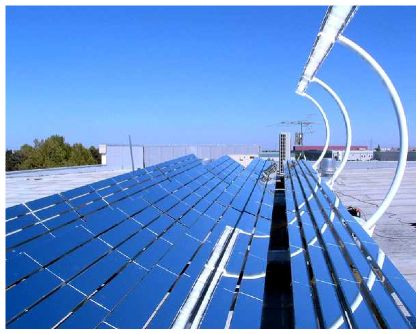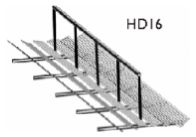Feasibility Study on Concentrated Solar
We must go through a basic feasibility study to understand the importance and potential of solar concentrator power. First, we are considering solar concentrators for solar electric power. While there are many solar electric system options available- from photovoltaics and stirling engines to Rankine cycle low temperature electrical generators and many others - we believe that solar concentrator-powered boundary layer turbines are the lowest cost, most ecological, and simplest to manufacture route - for bringing in solar energy as a mainstreamable source of energy for advanced cultures. The future of energy is solar.
NOTE: Note also that solar cells do hold good promise in the future. This would be feasible, in a decentralized economic system, if solar cells are able to be produced in small scale facilities. One such technology is ribbon PV technology, extruded using an appliance-sized machine that takes only 1 kW of power (see Evergreen Solar for an example). Moreover, this can be accomplished in a decentralized economic system only if the raw feedstock - solar grade silicon - can be produced in distributed locations - such as, even, Factor e Farm. Silicon is made from sand, and sand is ubiquitous. If abundant energy is available (such as solar concentrator power), then it is just a matter of procedure to produce all the solar grade silicon that is needed - and transcend the present "shortage" of pure silicon. The latter is merely an artifact of the economy of scarcity, where non-value-neutral technologies promoted by special interests dominate the landscape.
Solar Power Basics
Consider these basic facts relevant to solar power:
- Solar insolation on a clear day is about 1 kW/square meter
- Considering cloud cover and day/night cycles, a place like Missouri gets 6 kWhr/square meter/day of insolation throughout the year, on average. [1]. You can check the insolation for your location in the uSA as well.
- The earth intercepts 10,000 more times energy from the sun than we currently use in all fossil and nonfossil fuels today.
- The energy intercepted per acre of land is 4 megawatts.
- If overall energy conversion efficiency for that land area were 5%,
then you would produce 200kW of power from that acre of insolation.
- The boundary layer turbine is proven to be at least 25% efficient for unoptimized experiments in the literature. [2]
- Counting overall system efficiency, 10% efficiency is easily attained
- If only half the land area is solar collectors (rest is access, etc.), then 5% is a reasonable figure
- The 200 kW obtainable per acre is comparable, on a per-acre basis, to
coal power plants.
- Coal power plant of 1 square mile - 640 acres/mile * 200kW/acre ~ 100 MW output per square mile if the area was in solar concentrators. So, 10 square miles would constitue a gigawatt solar power plant. This is comparable to the area and output of coal plants.
- A solar thermal electric plant of 177 MW on one square mile was recently installed in California - [3]
- Nuclear power plants are typically 1 square mile in size [4]
- The 200 kW/acre is also twice the per-acre power of the most advanced
Stirling engine thermal electric generators.
[5]
- This is not because the advanced Stirlings are not efficient, but because there is so few of them per acre.
We are proposing linear collectors of this type:
 from
[6]
from
[6]
Cost
And basic cost figures are:
- For comparison, coal and nukes are about $1500/kW of installed power
- Fuel costs for coal are about 1.5 cents/kWhr
- Total energy production costs are 4-10 cents/kWhr [7]
- Cost of mirrors for such a collector is about $1/sq ft
- The heart of a solar collector is mirrors
- Balance of system costs for the collector incude structure and
collector tube assembly
- Balance of system costs should be about $5/sq ft
- Costs for solar cells that are presently available are $40/sq ft, or a factor 8 more
- The boundary layer turbine [8] material cost is negligible compared to the collector cost - $300 for the model that we are developing
- Collector costs for the 5 kW turbine generator are:
- 500 square feet => 50 sq meters => 50,000 W @10% efficiency => sufficient for 5 kW electric generation
- But, turbine scales at $20 per additional kilowatt of power output, and $40 for additional electric power output.
- Cost of 500 square feet is $2500.
- Nominal 5 kW system costs $3500, which is <80 cents/watt of installed power
- Nominal 100 kW system costs $50,000 for solar concentrators, and $2500
for generator heads, and about $2500 for the turbines.
- Total of $55k for 100 kW or about 55 cents per watt of installed power
Bottom line: For anyone who understands these numbers, this "we can be sure it will change life as we know it", quoted regarding energy from another article discussing P2P energy solutions. This is cheaper than any known power generation strategy.
Note the assumptions:
- Open source design fuels advanced, small-scale, optimized digital and flexible fabrication
- As such, labor costs are minimized
- Fabrication infrastructure may be capitalized via voluntary contributions from stakeholders, such as we're exploring- as a novel way to fund productive infrastructures
Note that laser cutting may be required for turbine fabrication, but this tool should also be opensourced and made available at a predicted cost of $5k for a laser cutter for 1/16 inch stainless steel plate.
Reality Check
One must study the above data carefully to become convinced of the possibility. The greatest question that may arise is not whether the efficiency of the turbine is correct. The figure of 10% that we are using has been proven, and it is conservative. The real question is, can the cost deliverables be met.
Using the simplest possible structural design for the concentrators, described in our proposal in Fig. 5a, such as:
the $5/sq ft balance of system cost should be achievable. If it is not achievable by utilizing off-shelf steel or lumber components, then we will utilize compressed earth blocks [11] and self-milled lumber [12] to reach the cost requirement.
Weak Link in the System
The weak link in the system is the boundary layer turbine itself. So far, we have heard conflicting messages on its feasibility. Scientific journals have showed 25% efficiency for a small, steam-powered boundary layer turbine. If that is true - then this is enough information to go on to take on the development of the turbine. Indeed, I found that Dan Granett ran a 16-disk, 12-inch diameter turbine successfully on compressed air to generate 4 kW of electric power. His design did not have seals, so he designed a simplified turbine, with seals - Boundary Layer Turbine - which is the design that we're working on.
We are interested in tracking down those researchers. One of them is Warren Rice, author of the above 25% turbine paper. He was professor of Engineering Science at Arizona State University, Tempe, AZ, when he wrote the paper in 1963. We would appreciate any help in tracking down the true story of why the boundary layer turbine has not attained wider acceptance.
If there is a small-scale turbine that is so efficient, why has this not been commercialized? Our research indicates that this is because much more efficient bladed turbines have been produced. However, those turbines are at least a factor of 10 times more expensive. Thus, for particular applications, the boundary layer turbine may be a suitable, cost-effective option. This is also the conclusion drawn on p. 35 of Rice, Warren, Transactions of the ASME, Journal of Engineering and Power, January 1965.
If the turbine does not work as expected, we will move on to other options. One retrogressive option could be as primitive as proven steam engines, which are 5% efficient for unoptimized models. We are talking of ridiculously low performance, but if the final system cost is correspondingly low, then we just might have a technology that could change the world. Indeed, 5% efficiency is a factor 3 lower than solar cells - and given the significantly lower cost per installed watt than photovoltaics, that may be a much better solution than photovoltaics.
Night Time Operation
Night time operation is feasible by using heat storage. This is done by Ausra on the commercial level already. [13]
Tamera has hot oil system in place - http://www.solarpowervillage.info/
http://peswiki.com/index.php/Congress:Top_100_Technologies_--_RD#Top_100 says:
Stirling Energy Systems utility solar - 20-year purchase agreement between Southern California Edison and Stirling Energy Systems, Inc. will result in 20,000+ dish array covering 4,500 acres capable of generating 500 MW, at a cost competitive to grid power. 37 foot diameter dishes. Each dish yields 25 kW. Nice. pi*18^2= 1074 sq feet, or exactly 100 square meters. 25% overall efficiency for the most advanced Stirling engine.
This is 100 kW/acre. Our calculations indicate 4 mW/acre, at 5%, 200 kW/acre. 50% fill factor, 100 kW/acre.
Ecological Review
Flat concentrators are the simplest to manufacture. They can also be scaled infinitely. Parabolic ones are scaleable, too, but expensive. Dish systems are even more expensive, and not scaleable.
Photovoltaic systems have been out of reach for society since they were invented. In our opinion, they will not become affordable to consumers until a true renegade innovator, not mainstream companies, make them available. Today, with no technological breakthroughs, solar concentrators may be implemented. If developed in the open source context, we predict 80 cents/installed watt as above. Welcome energy abundance, bye-bye to many of the present geopolitical quabbles.
All references go to OpenFarmTech. Article first published at: http://openfarmtech.org/index.php?title=Solar_Concentrators
